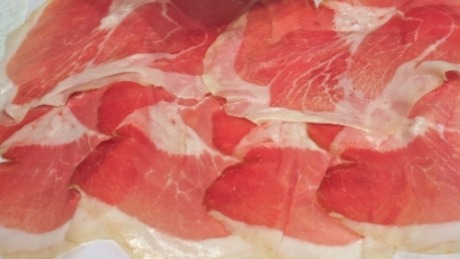Time To Ham It Up: A Guide To Cured Hams
You know it's been a long, long winter when you a) run out of things to braise and b) get busted doing "repeat" dinner parties because you have run out of things to braise. So, in proper avoidance of all things braised and banal, I suggested to a dozen of my foodie friends we might have a dried ham tasting. "A what?" they said. "Dried ham... you know, like prosciutto," that catchy descriptor for any kind of thinly sliced, air-dried meat. But it's more complicated than that.
Dried meat, in general, has been around since the stone-age. Uncooked, dry-cured hams are commonplace in most European countries and the history of cured meats goes back to Roman times. The salt used in the curing process draws out the moisture in the ham as it is hung to age. The hams go through a natural air-curing process where they are exposed to cool, dry air for up to three years, resulting in preservation through dehydration. Dry-cured hams are also called "country hams." The hams may also undergo several pressings to further eliminate moisture and intensify flavor. National and regional differences in taste, texture, and price are manifest through the various pig species used, their diets, different curing spices, and drying times.
We tasted seven different types: three from Spain, three from Italy and one from Virginia. The whole lot was surprisingly inexpensive: around $70 for about 100 slices. The results of our tasting are listed below ranked most favorite to least favorite. You might try something like this with your food-loving friends in conjunction with a wine tasting; it is always a good idea to pair regional foods with indigenous wines since they probably evolved together. For instance, match the Mangalica, Iberico, and Serrano with wines from Jumilla or southern Spain, although a good Ribera del Duero will do in a pinch. For the Prosciutto di Parma, try a Sangiovese di Romana. A high-altitude red, like Schiava, from Trentino-Alto Adige would match well with the Speck, and a Refosco from Friuli for the Prosciutto di San Danieli. If you can't find some of these, ask your local wine shop for assistance.
If you like ham, it's a delicious way to break out of the winter doldrums. Make sure your ham is sliced "as thin as a bee's wing" and serve it at room temperature to get the best mouth-feel.
Jamón Mangalica This exquisite Spanish ham is made from the Mangalica breed of pig. They are originally from Hungary and live in a cold climate. It is noted for its high fat content and overall marbelization. They are free range. Our absolute favorite. A buttery, silky texture with very dense, sweet flavor, and a faint hint of clove. Not too salty. Cured from 30-36 months. It has very limited production.
Jamón Iberico: Iberian ham represents only 5% of all Spanish production. It is made only from the black Iberian pig bred in southwest Spain. There are three different classes. The best is fed grain initially but then are free range during the last couple months and eat acorns or bellota. Cured 14-36 months. Firmer texture, nutty, dense, sweet, flavor. It is quite possibly the most expensive pork product on the planet.
First documented by Tyrolean princes in 1200 this air-dried ham is also smoked, representing the best traditions of both Tyrol and the Mediterranean. Sweet and balanced with a slightly smoky after- taste. It is firmer in texture.
Prosciutto di San Danieli: This guitar-shaped ham comes only from the City of San Danieli in the heart of Friuli. The winds that descend from the Alps meet those coming in from the Adriatic to create a unique micro-climate for curing. It is made only from pigs that are raised in the 10 most northern provinces. Cured at least 12 months. Soft texture and slightly salty with a mild and buttery flavor.
Prosciutto di Parma: Designated only from the city of Parma in Emilia-Romagna in north-central Italy. Reputed to be the best because of the combination of diet (the pigs are fed the left-over parmesan whey and chestnuts) and the dry, aromatic mountain breezes. We didn't think so. Although buttery and soft we found it too subtle in taste when compared with those above. Aged at least 10 months many are coated with lard during the last few months for smoother texture.
Dried Virginia Ham: A country ham produced throughout the Appalachians imported along with the traditions of western European immigrants. Using the Berkshire black pig raised mostly on corn these hams have a high degree of marbling but are very salty due to the long curing time needed in more humid climates. They are smoked over hard wood and meant to be soaked and cooked before being eaten. We decided to try it dry to see how it matched up. We found it intensely flavorful but dry, and too salty to eat raw.
Jamón Serrano: It is also called mountain ham and there are almost 2000 producers in Spain. It is made from several different breeds of white pig and fed a diet of grains and is not associated with any particular geographic region. Aged for 7-16 months. Surprisingly, our least favorite. We thought it strong-tasting, chewy and salty with an unpleasantly fatty mouth-feel.

